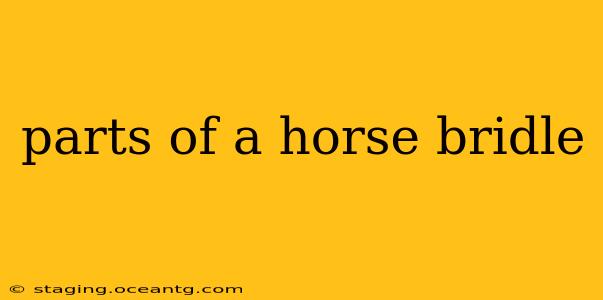Understanding the parts of a horse bridle is crucial for anyone involved with horses, from experienced riders to curious onlookers. A bridle is more than just a bit; it's a complex system of straps and buckles designed to communicate with the horse, allowing for control and guidance. This guide will break down each component, explaining its function and importance.
What are the main parts of a horse bridle?
The core components of a bridle are the bit, the headstall, and the reins. However, many bridles also incorporate additional pieces to enhance control and comfort. Let's delve deeper into each part.
The Bit: The Communication Center
The bit is the metal piece placed in the horse's mouth. It's the primary tool for communicating with the horse, influencing its movement through pressure and release. Different bits exist, each with varying degrees of severity and leverage, catering to different horses and riding disciplines. Understanding bit types is a crucial aspect of horsemanship.
The Headstall: Securing the Bit
The headstall is the part of the bridle that sits on the horse's head, holding the bit in place. It typically includes:
- Crownpiece: The top strap that sits across the horse's poll (the top of the head).
- Browband: The strap that sits across the forehead, often decorative.
- Cheekpieces: The straps that extend from the crownpiece, connecting to the bit and the throatlatch.
- Throatlatch: The strap that secures the bridle under the horse's throat. It prevents the bridle from slipping up over the horse's ears.
- Reins: These are the long straps that connect to the bit and are used by the rider to communicate with and guide the horse.
Additional Bridle Components: Enhancing Control and Comfort
Many bridles incorporate additional parts to improve control, fit, or comfort:
- Noseband: A strap that goes across the horse's nose, often used to prevent the horse from opening its mouth excessively or pulling against the bit. Several types exist, including cavessons, flash nosebands, and drop nosebands, each with its unique function and impact on the horse.
- Cavesson: A separate noseband, sometimes used in conjunction with other nosebands or as a standalone piece for specific training purposes.
- Lip strap: A thinner strap that runs under the horse's chin, similar in function to a throatlatch but providing additional security.
- Martingale: A device that prevents the horse from raising its head too high, attached to the reins and the girth.
- Running Martingale: A type of martingale with two straps running from the reins to the girth.
- Standing Martingale: This has one strap attached to the reins and one that attaches to the breastplate.
What is the purpose of each part of a horse bridle?
The purpose of each part is intricately connected to ensuring both control and the horse's comfort and well-being. Improper fit or use of any component can lead to discomfort and resistance in the horse.
How does a bridle work?
The bridle works as a system, with each part playing a vital role in communication between horse and rider. The reins allow for precise control, while the headstall ensures the bit remains correctly positioned in the horse's mouth. Additional components offer further refinement and control.
What are the different types of bridles?
Several bridle types exist, each designed for specific disciplines or training purposes. These include the snaffle bridle, double bridle, hackamore, and sidepull. Each type differs in its bit and often in the inclusion or exclusion of specific components like nosebands or additional straps.
Understanding the parts of a horse bridle is a fundamental aspect of responsible horsemanship. Knowing their function allows for better communication with your horse, leading to a safer and more enjoyable riding experience. Choosing the right type of bridle and ensuring a proper fit are crucial for both rider safety and the horse's comfort and well-being.
